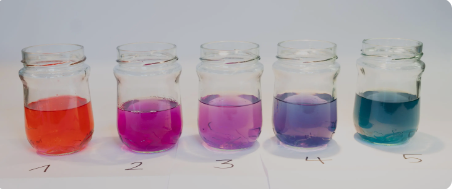Synesthesia or Different Colored Juice?
Grade 8
Presentation
No video provided
Hypothesis
If the participants drink each of the juices, red will be associated with a sweet taste, yellow and green with a sour taste, blue and purple with a bitter taste, because all these colours are associated with these general taste cues. There will be a bias towards red juice because it is considered to be more sweet, and against yellow because it is considered to be more salty.
Research
Colour Perception
Colour perception in food can influence an individual in many different ways. From sour to sweet, the human brain can perceive how a food tastes based on its colour. While colour does not have a taste to itself, the human brain processes the colour as a "flavour" because humans often see their food before smelling or eating it, percieving the taste of the food to the colour
In 2009, Proffesor Spence conducted a similar experiment with clear blue juice. People from the UK thought the drink would taste of blue rasberry and people from Taiwan thought it would taste of mint. This shows how cultural backgrounds can affect someone's initial taste perception of a particular colour.
Synesthesia
Synesthesia is a phenomenon that occurs when one has a crossover between their senses. For example, associating touch and sound, or taste with seeing colour. Synesthesia is not an illness in the brain, but it can count as a symptom of one. Synesthesia is most common in children and slowly starts to become less prominent as they grow older. Synesthesia works by first detecting your surroundings, signalling it to your brain, and then porcessing what it is. During the processing, connections are made between senses.
Variables
Manipulated Variable: The colour of the juice (red,yellow,green,blue,purple)
Responding Variable: their input on the taste of the juice.
Controlled Variable: The amount of juice in each cup, the amount of food colouring in each cup, the same questions, the same colours in each experiment, participant age range. Type of juice (apple)
- Akshara 28 Feb
Procedure
1. Participants are required to sign a consent form with a parent / guardian's permission before experiment takes place.
2. Participants are asked to meet at the second half of lunchtime break (11:55) in the science room for the experiment. The experiment ran between a span of a week.
3. Juice is prepared before the participants arrive (11:35 - 11:50), all of which are measured carefully, making sure the colouring and juice amount is controlled.
4. Each particpant gets five cups with 10ml of juice in each cup in the following colours in the following order (right side of participant): red, yellow, green, blue, purple.
5. Participants are then asked to drink the juices in whatever order that is preferred and then is asked questions about the juices they tasted.
6. The data is then compiled into one table.
- Junita Feb 28
Observations
During the trials we noticed that younger kids (grade 7s) had more varied data while older kids thought it tasted the same. Based on our research we found out that symptoms of synesthesia lessens as age increases, meaning the grade 7s could have shown more noticeable symptoms of synesthesia than the older kids.
We also noticed that many people drank the juices in the order they were given althought they were told that they could drink it in any order. This sign could have shown that students did so as they believed the order of the colours (red, yellow, green, blue, purple) had some kind of reason.
Analysis
Using the data shown in the table, I can see that:
- People thought the most salty juice was yellow
- People's favourite juice was purple
- People's least favourite juice was yellow
- People thought the sweetest juice was yellow and green
- People thought the most sour juice was every colour but purple
- 3 people thought all the juices were the same

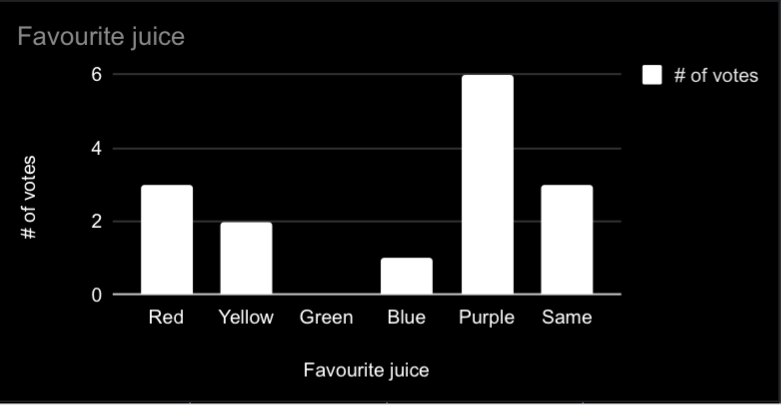
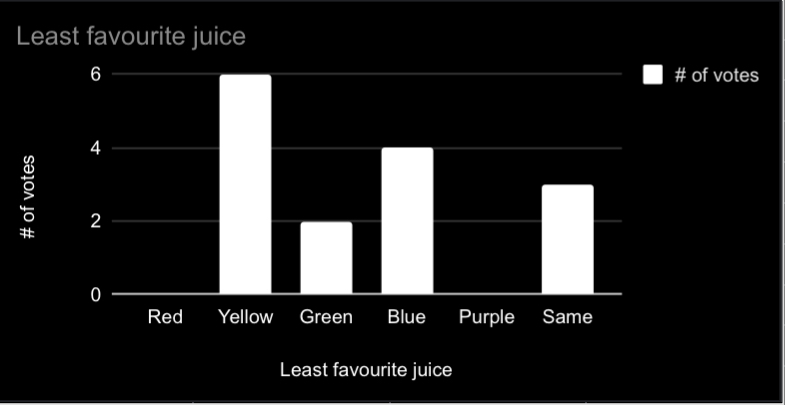
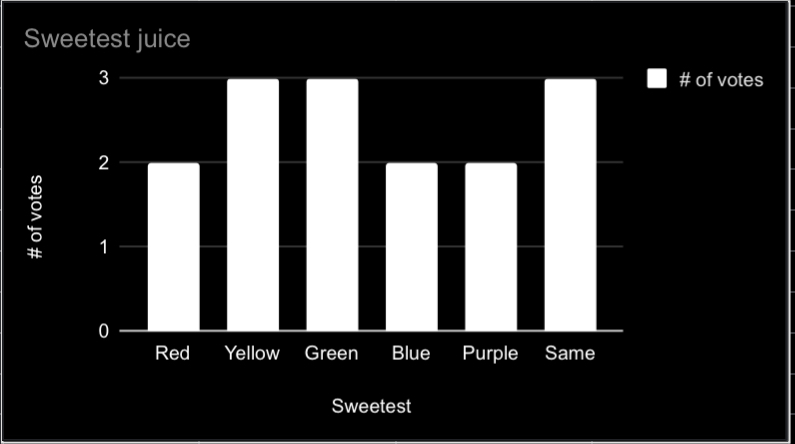
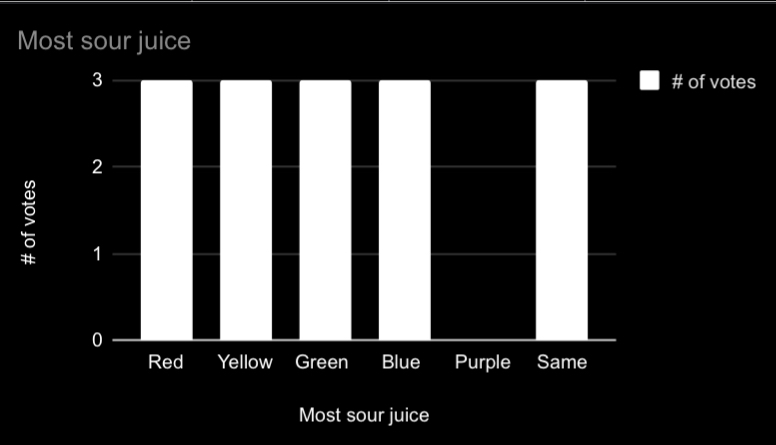
Conclusion
The following hypothesis was proven incorrect. Based on people's perception of the different colours, many had a very different opinion from each other. Based on the following data we can conclude that the most favorite juice was purple at 6 votes, with the least favorite being yellow at 6 votes. The most salty juice tasted was considered to be yellow at 6 votes, the most sweet to be yellow and green all tied with 3 votes each, and with the most sour juice being red, yellow, green, blue, all tied with 3 votes each. There were also 3 participants who believed that all of the juices tasted to exact same. The reason for the result of people choosing yellow as their least favourite was because they thought it was the saltiest and purple as their favourite because it was rather sweet.
Application
How does the colour of the food percieve the taste? Colour perception can be really beneficial or damaging to major food companies. Companies canfind out which colours of food their consumers perfer or dislikeand could make a productwith or with that colour.The company's products could be percieved nicley or terrible and it could just be because of the colour rather than the actual taste.
An example of a sucessful but latter unsuccessful product is the infamous "Funky Purple" and "Blastin Green" Heinz ketchup. The colourful kechtup started off as a very sucessful product but was laster pulled from the shelfs due to colour perception. As the world got bussier, our colour perception became more clear, the purple and the green coloured ketchup being considered too bright and different unable to satisfy people in the later ages unlike the 90s. Based on the experiment info and Heinz's colourful ketchup, it can be seen that colour perception is always changing, it can be because of one's favourite colour, their experiences, their memories, all of which can make colour perception different for each person.
- Junita Mar 1
Sources Of Error
The colouring was not measured on the for the first 3 tests on the first day, later was corrected and all colours was measured for the following participants and days coming after.
Testing days could have been more organized. Some testings days canceled and rescheduled due to scheduling conflicts with participants themselfs and school ( absence, extracurricular, etc.) which led testing to take longer then expected.
Citations
Glass, Sandie. “What Were They Thinking? The Day Ketchup Crossed the Line From Perfect to Purple.” Fast Company, 14 Sept. 2011, www.fastcompany.com/1779591/what-were-they-thinking-day-ketchup-crossed-line-perfect-purple. Accessed 2 Mar. 2024.
Wood, Caroline. “How Does Colour Affect the Way We Eat?” Foodunfolded, 23 Jan. 2024, www.foodunfolded.com/article/how-does-colour-affect-the-way-we-eat#:~:text=All%20of%20us%20subconsciously%20associate,brown%20and%20black%20with%20bitterness. Accessed 2 Mar. 2024.
“What Is Synesthesia?” Cleveland Clinic, 3 May 2023, my.clevelandclinic.org/health/symptoms/24995-synesthesia. Accessed 2 Mar. 2024.
Spence, Charles. “On The Physiological Impact of Food Colour.” BMC Psychology, 22 Apr. 2015, flavourjournal.biomedcentral.com/articles/10.1186/s13411-015-0031-3. Accessed 2 Mar. 2024.
“Does Colour Affect Taste.” Colour Matters, www.colormatters.com/does-color-affect-taste. Accessed 2 Mar. 2024.
“How We Perceive Colour Depends on Our Culture and Language.” Horizon- the EU Research and Innovation Magazine, 15 Nov. 2016, projects.research-and-innovation.ec.europa.eu/en/horizon-magazine/how-we-perceive-colour-depends-our-culture-and-language-prof-anna-franklin. Accessed 2 Mar. 2024.
https://www.ncbi.nlm.nih.gov/pmc/articles/PMC5030750/
https://phys.org/news/2018-11-codedmatching.html
https://www.prompthunt.com/prompt/clcnz5x2l0h64p6qpa4q8y4pq?selectedAsset=clcnz5z7w0h66p6qprhz9baa5
https://www.prompthunt.com/prompt/clcnz5x2l0h64p6qpa4q8y4pq?selectedAsset=clcnz5z7w0h66p6qprhz9baa5
Acknowledgement
We would like to thank the following: Mr. Dayson for providing the science room as the room where our experiments took place, Junita's mom for providing a place to work on science fair on the weekends, and the participants who took part, and their gardians for consenting to this science experiment.

